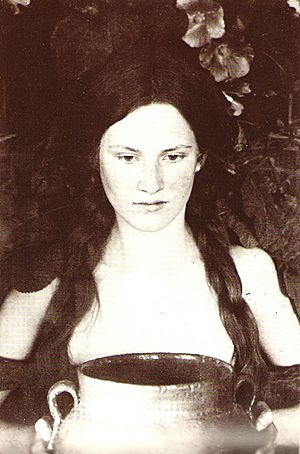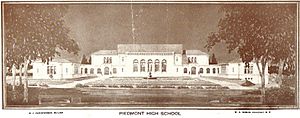History of Piedmont, California facts for kids
Piedmont, California, is a small city in the San Francisco Bay Area of California. Its history is full of interesting stories, from its early days as ranch land to becoming a bustling city.
Contents
Early Days of Piedmont
In 1850, the land that is now Piedmont was part of a huge ranch called Rancho San Antonio. This ranch belonged to the Peralta family. It covered a large part of the eastern side of San Francisco Bay, which is now northern Alameda County. The ranch was mostly empty, with just cattle and the vaqueros (cowboys) who looked after them.
Around 1860, a retired politician named Isaac Holmes bought some land in the area. This land included a stream called Bushy Dell Creek. Holmes believed that the pink, smelly water from a nearby spring could help his rheumatism (a type of joint pain).
The Piedmont Springs Hotel Era
In 1870, a man named Walter Blair bought over 800 acres (about 3.2 square kilometers) of land in the hills of the East Bay. He built the Piedmont Springs Hotel right where the special spring was located. The hotel had 20 bedrooms and five dining rooms. People thought the spring water had healing powers. Rich people from San Francisco would visit the hotel for relaxing trips to the countryside.
Besides the hotel, Blair also built a dairy farm on what is now Highland Avenue. He also started a quarry (a place where stone is dug up) where Dracena Park is today. Blair also helped create the Broadway and Piedmont Railroad. This railroad used horsecars to carry people to the area.
In 1877, a businessman named James Gamble bought 350 acres (about 1.4 square kilometers) from Blair. He started the Piedmont Land Company with other partners. This company hired a landscape engineer, William Hammond Hall, to design the streets and divide the land into 67 smaller plots. The first land sale happened on April 10, 1877.
In 1891, some women in Piedmont started a movement to stop the sale of alcohol at the Piedmont Springs Hotel. They asked the Alameda County Board of Supervisors to take away the hotel's liquor license. Many important women signed the petition, including Annie Barton and Mary Gamble.
The Hotel Fire
The debate about alcohol at the hotel ended suddenly. On November 17, 1892, sparks from the hotel's chimney set the roof on fire. Newspapers reported that there was no water nearby to fight the fire. People staying at the hotel could only watch it burn. Firefighters from Oakland arrived two hours later to try and control the flames.
The Bohemian Artists of Piedmont
In 1900, the famous writer Jack London married Bess Maddern. They moved into a redwood house in the hills east of Oakland. This area was becoming a home for artists. It was here that London wrote his famous novel Call of the Wild. His two daughters, including Joan London, were born during this time.
In 1902, London moved to 206 Scenic Avenue. A historian named Ann Swift said he "tried to create a childhood he never had" there. He would entertain his friends, fly kites, have bubble-blowing contests, and even see who could eat the most soda crackers.
London's friends were also artists and writers, including George Sterling, James Hopper, Herman Whitaker, Xavier Martinez, Blanche Partington, and Charmian Kittredge. After London divorced Bess Maddern in 1904, he married Charmian Kittredge.
These artists were called the Bohemians. They lived different kinds of lives than most people, focusing on art, writing, music, and acting. Unlike their rich neighbors, the Bohemians often built their own homes because they couldn't afford to hire others.
Piedmont Becomes a City
Two important men, Francis Marion Smith and Frank C. Havens, helped Piedmont grow into a city. Smith made a lot of money from borax (a mineral) and built railroads, including the Key System in the East Bay. Havens led the Realty Syndicate, a company that divided 13,000 acres (about 53 square kilometers) of East Bay land into smaller plots. Havens leased the Piedmont Springs Park and worked hard to fix it up. The new park opened in May 1898.
In 1901, Piedmont got its first post office.
In 1908, Havens built an art gallery where the tennis courts are today. Carrie Sterling, who was married to George Sterling (Havens' nephew), was in charge of the gallery.
Piedmont's population grew four times larger after the 1906 San Francisco earthquake. Many people from San Francisco moved to the hills of Piedmont because they thought it was safer from earthquakes. To handle the growing population, a new city hall and fire station were built near the park.
In 1907, citizens of Piedmont voted twice on whether to become a city. Both times, the decision to become a city won by a small number of votes.
By the 1920s, Piedmont was known as the "City of Millionaires." This was because it had more millionaires per square mile than almost any other city in the United States. Many of these wealthy people built huge mansions that are still standing today, especially on Glen Alpine Road/Sotelo Avenue and Sea View Avenue. Piedmont officially became a charter city under California law on December 18, 1922. On February 27, 1923, voters approved the city's charter, which is like its rulebook. This charter can only be changed by another vote of the people.
After Frank Havens passed away, Piedmont Park was going to be divided and sold. But Wallace Alexander, who had just moved to Piedmont, stepped in. He loaned the city enough money to buy the park. He also encouraged a Bay Area architect named Albert L. Farr to create the Civic Center Plan.
The Civic Center Plan
The Civic Center Plan was shown to the community in 1922. It suggested making City Hall bigger, building a city library, and connecting the entrance of Piedmont Park to the electric trolley line, which was the main transportation back then. However, most of this plan did not happen. The exedra, which is a curved structure with the famous vase of Piedmont, was built at the start of Piedmont Park. Piedmont High School was built in 1921 and opened in 1922. It was paid for by a bond (a type of loan) that voters approved in 1920. But the stock market crash of 1929 caused many people to lose their money. This stopped the rest of the plan from being finished, as there wasn't enough money for it.
Piedmont High School
Before Piedmont High School was built, students would go to elementary school in Piedmont. Then, they would go to junior and senior high school in Oakland. In September 1922, the Piedmont Unified School District opened the city's first high school. The school was built in 1921 in a neoclassical design, which means it looked like old Greek and Roman buildings. This was part of the same plan that built the Piedmont city's Exedra. A cafeteria was added in 1923, a library in 1924, and a junior high school next door in 1926.
Since it was designed by architect W.H. Weeks, the school has been rebuilt several times. This was done for things like making it bigger, making it safer from earthquakes, and fixing problems like dry rot. In 1974, the school was found to be unsafe under state earthquake laws. It was torn down, and three new classroom buildings and a gym were built. The original library, quad (courtyard), and administration buildings were repaired.
In the 1920s, the high school had an equestrian club for students. They would ride their horses around Piedmont, which was much less developed back then. Girls wore sailor-suit tops with uniform skirts. Boys had stricter dress codes than today. Original artwork decorated the school walls.
Since its creation, Piedmont High School has often needed more money for construction. For example, an extra $100,000 was needed to expand the school early on. In the 1970s, a breezeway (an open hallway) was added. In 2003-2004, an entrance and trophy room were added to the gym. In 2006, voters approved Measure E, which provided $56 million to make the city's schools safer from earthquakes.





